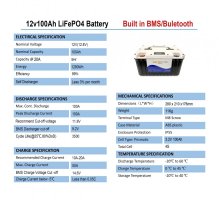OK so I have been doing some experimenting with induction cooking v gas, as in my next build I am thinking I want to be just induction. But I am getting some weird readings that I am not really sure how to interpret and possibly my Lithium batteries aren’t as good a quality as others.
The system
2x 100Ah LiFePO4
1 x 2500w pure sine wave inverter
1x 2000w single Westinghouse induction cooktop
1 x voltronic shunt meter.
160W solar on roof though PWM controller, this is what is built into the NDS DC-DC charger, but this doesn’t really factor in to the testing. If I have fridge on I get a negative over 24 hr so deff need a bit more solar and MPPT controller on next build. DC-DC charger saves the day the
The Test
OK so I start off at full 200Ah as indicated on shunt, fill kettle and put on induction at full 2000w, leave on for 3mins
Draw is indicated (on shunt) at 162-165 amps and at end shunt indicates 189Ah remaining (11Ah used).
Repeat test, same as above
Draw same as before and after 3 mins we now have 176Ah (13Ah used) in battery as indicated by shunt.
So if I do some maths (feel free to correct this if wrong)

Over the 6 mins it has drawn 24Ah (11 on tst 1 and 13 on tst2) from total of 200ah that is 12% of total capacity
On actual draw – 162amp /60secs = 2.7Ah/min x 6min = 16.2Ah that to me is now 8.1% of total capacity
So there is a diff of 8Ah somewhere!
When I have been away it seems to draw more as the battery gets lower. Other than looking at the shunt I don’t know how to do a secondary capacity test.
Watching a few youtube vids on this it seems that the draw of 162amp is about right but the amount it taking from battery seems excessive, hence my wondering if my batteries are a bit to ‘cheap’….. (have attached spec sheet of them) or maybe I just don’t have enough battery capacity
On my next build I have already built a battery from separate cells (230ah) with Dally BMS etc
So possible reasons.
So opinions please.
Seems Bryn23 has done something similar but he knows what he is doing
The system
2x 100Ah LiFePO4
1 x 2500w pure sine wave inverter
1x 2000w single Westinghouse induction cooktop
1 x voltronic shunt meter.
160W solar on roof though PWM controller, this is what is built into the NDS DC-DC charger, but this doesn’t really factor in to the testing. If I have fridge on I get a negative over 24 hr so deff need a bit more solar and MPPT controller on next build. DC-DC charger saves the day the
The Test
OK so I start off at full 200Ah as indicated on shunt, fill kettle and put on induction at full 2000w, leave on for 3mins
Draw is indicated (on shunt) at 162-165 amps and at end shunt indicates 189Ah remaining (11Ah used).
Repeat test, same as above
Draw same as before and after 3 mins we now have 176Ah (13Ah used) in battery as indicated by shunt.
So if I do some maths (feel free to correct this if wrong)

Over the 6 mins it has drawn 24Ah (11 on tst 1 and 13 on tst2) from total of 200ah that is 12% of total capacity
On actual draw – 162amp /60secs = 2.7Ah/min x 6min = 16.2Ah that to me is now 8.1% of total capacity
So there is a diff of 8Ah somewhere!
When I have been away it seems to draw more as the battery gets lower. Other than looking at the shunt I don’t know how to do a secondary capacity test.
Watching a few youtube vids on this it seems that the draw of 162amp is about right but the amount it taking from battery seems excessive, hence my wondering if my batteries are a bit to ‘cheap’….. (have attached spec sheet of them) or maybe I just don’t have enough battery capacity
On my next build I have already built a battery from separate cells (230ah) with Dally BMS etc
So possible reasons.
- I just don’t have enough battery capacity
- Batteries are cheap!
- Note battery has max cont discharge of 100A so that could be an issue ?
- Could get smaller induction hob but then would just take longer to boil
So opinions please.
Seems Bryn23 has done something similar but he knows what he is doing
